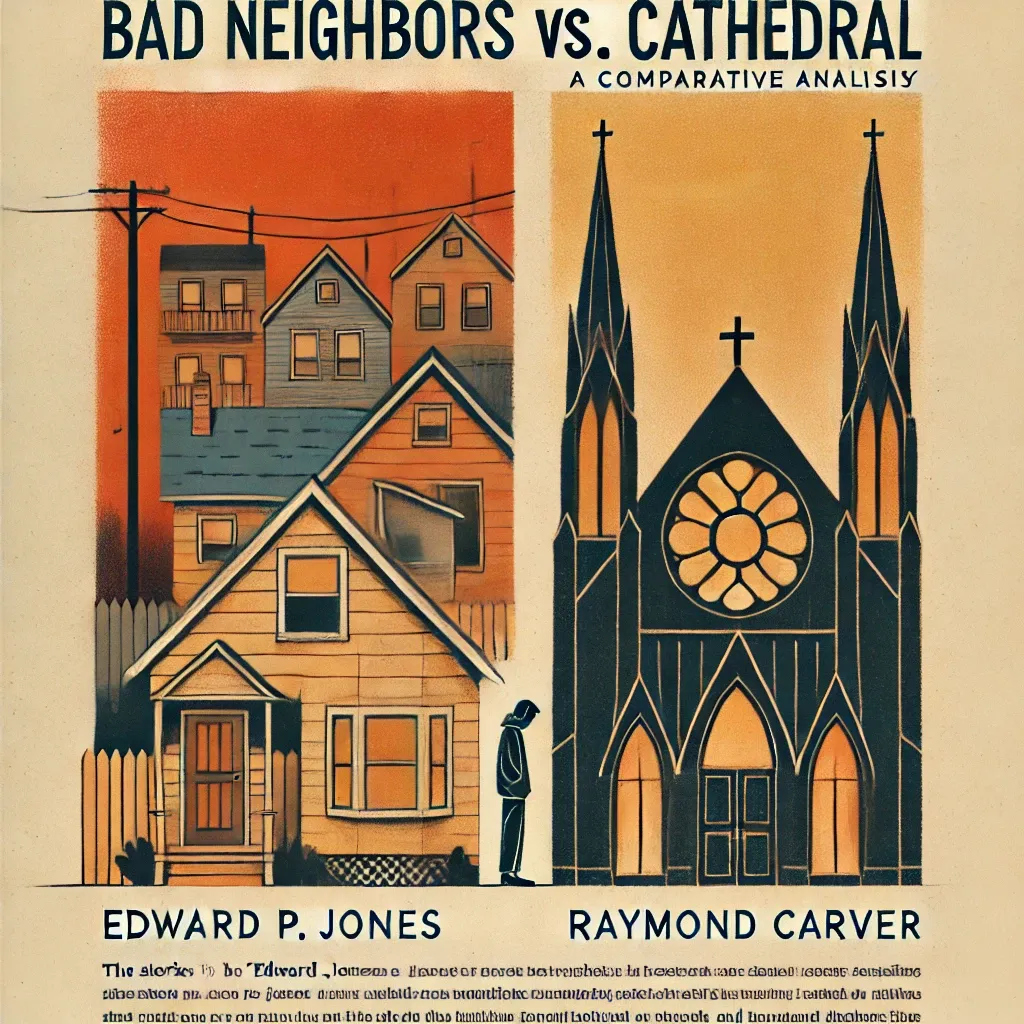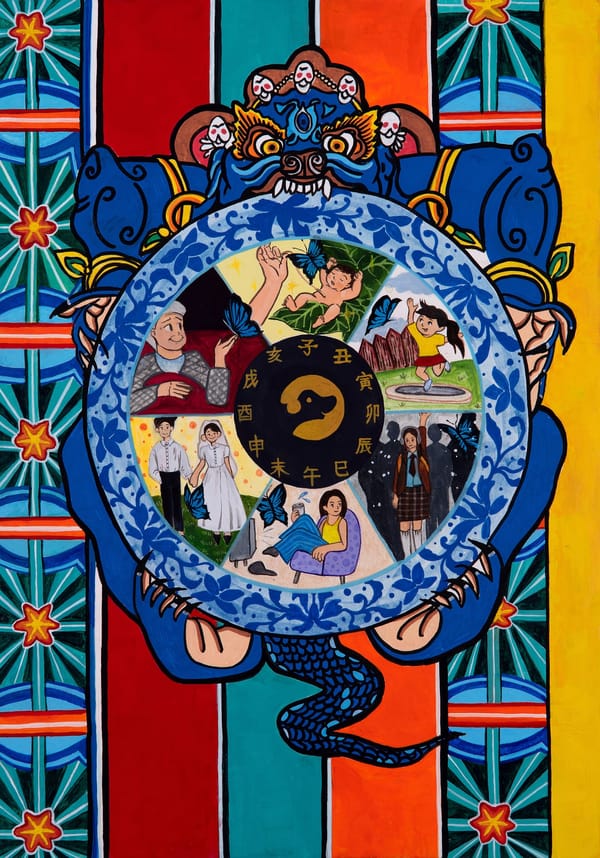Short Story Analysis: “Bad Neighbors” and “Cathedral”

From the acceptance of a refugee seeking asylum to a new student invited to a lunch table, the belief in the common human identity has given shelter to those who have experienced exclusion, often through the expulsion from a physical space or location. Against injustice and isolation, the reach of a hand based on love and humanity is fundamental to the widespread charity and unity in the world today. In the short stories "Bad Neighbors" by Edward P. Jones and "Cathedral" by Raymond Carver, the authors examine the formation of such an interpersonal community or its absence through the overcoming of the characters’ states of exclusion. Ultimately, these short stories convey that the pursuit of this community offers purpose and allows everyone to become insiders regardless of physical exclusion; in "Bad Neighbors," Derek overcomes others’ attempts to instill inferiority and exclude him with authentic love and connection, while in “Cathedral,” the narrator discovers companionship and empathy through forming a bond beyond the initial ostracism he experiences.
In "Bad Neighbors," Edward P. Jones employs the conflict between richer and poorer classes to convey how physical spaces and barriers are used to reinforce exclusion. The Benningtons move into a neighborhood, where their strange and poor appearance cause judgment and isolation; Terence Stagg, the son of the respected Stagg family, similarly judges the Benningtons’ son Derek: "like most of the men on 8th Street[,] he didn't think much of him; men like Derek had never seen the inside of Howard University, where Terence was in his second year, and they never would" (Jones 354). As a symbol of prestige, Howard University embodies the superiority, and in return, the condescension that Terence possesses toward Derek due to their social status. Terence, an insider destined for success and revered in the neighborhood, immediately designates Derek as an outsider, incapable of his accomplishments, both from Howard University and the neighborhood. The exclusion of Derek encapsulated through the ability to enter the university serves as an example of the access of physical space, or lack thereof, as a means to diminish one’s value. When Derek's sister parks her car in the parking spot in front of the Staggs' house, Terence gets into a fight with Derek and demands that they pull out. Unwilling to fold to the other, they exchange words of defiance: "'Ain't nobody own no parkin spot, neighbor. This a free country, neighbor,' Derek said, the keys jingling with his arm at his side. / 'I'm not your neighbor'" (360). The rejection of the Staggs’ possession regarding the parking spot demonstrates Derek’s unwillingness to be devalued simply because of the difference in wealth. Yet the parking spot, much like the superiority that Terence obtains from his status as a Howard University student, serves as a method of reinforcing their division with a physical possession of space. Concerning the neighborhood in which the story takes place, Lane Stagg, the father of Terence, recalls the transition from the all-white neighborhood to becoming the black neighborhood. Stagg mentions of his exchanges with his former white neighbors: "The white man and his family had been the last whites to live in that neighborhood. 'Come on over to Arlington,' his white former neighbors kept saying, 'the blacks are all off in that neighborhood so you hardly ever see them" (363). The introduction of the larger social theme of racial division expands the dichotomy between insiders and outsiders to the whole neighborhood – the cycle of injustice, from the microscopic level of the Benningtons losing their parking spot, to the larger era of racial segregation in the story’s setting, together demonstrate that the label of neighborhood to those in physical proximity means little. Worse, the lack of mutual support and a formation of a true community often leads to materialistic judgments that leave room for further exclusion.
Through the contrast of the materialistic world and spiritual love, Sharon’s eventual epiphany of her desire for a profound relationship stresses the permeating impact of a spiritual community. Sharon, whom Derek had secretly liked, chooses to marry Terence, and with the money he inherits from his grandparents, they lead a wealthy life in a better-off neighborhood. Coming home from nursing school, Sharon is confronted by a group of young students, who threaten and harass her. Derek suddenly emerges, and fighting the students to protect Sharon, he is stabbed. In Sharon's car back for treatment, he says, "I lied. Red wasn't a bad color. It was way good enough for you. Any color you put on is a good color, didn't you know that? You make the world. It ain't never been the other way around. You first, then the world follows" (370). The significance of Sharon in Derek's life, in which the "world" transcends the superficial appearance represented through the colors, offers him purpose despite the numerous cases of physical exclusion that he endures. This reconstruction of Derek’s world portrays the overcoming of physical barriers that spiritual communion provides; such reverence, even worship, implies the boundless impact of a nonmaterial connection that a mere material one could not provide. Sharon returns from the fight to a sleeping Terence, who had had sexual relations beyond their marriage and unlike Derek, did not care for her. Her emptiness is magnified when Terence’s indifference strikes her: “In their bedroom she decided against putting on underwear and so got into bed the way she came into the world. Terence stirred, pulled his foot back under the covers, but beyond that, he did nothing. Almost imperceptibly, the rightmost red number on the fine German clock went from two to three" (373). The symbolism of the clock indicates the material improvement in Sharon's life with her choice of Terence; however, the physical signs of red and the number three, representing the introduction of Derek into the space of the married couple, demonstrate that the spiritual connection between Sharon and Derek established through the latter’s true passion and sacrifice is ever-present despite the physical barriers that separate them: Derek, unlike the beginning of the story, has become an insider. The indifference from Sharon's naked appearance emphasizes the lack of meaning in physical appearance and space, from which Terence finds superiority. The manufactured "red" of the clock, representing Terence's lack of emotion towards Sharon, is contrasted to Derek’s passion for Sharon, both through him bleeding in protection of her and his attraction to her with that color, thus rendering the physical and material luxuries meaningless in comparison to the supernal compassion in Derek’s sacrifice. Overall, “Bad Neighbors” utilizes the evolution of a dichotomy between insider and outsider based on locational materialism to the eventual substitution of the two foils based on spiritual connection. Tracing an outsider’s journey to discovering a community, “Cathedral” similarly uses physical spaces to emphasize the pervasiveness of a relationship-based community that offers one purpose.
In “Cathedral,” Raymond Carver employs the exclusion that the characters experience with physical distance to convey that the presence of a community is a comprehensive space upon which no restrictions are placed. Describing the relationship between his wife and her blind friend, Robert, who is coming to visit his house, the narrator explains his wife's past with her ex-husband: "She sent tapes from Moody AFB, McGuire, McConnell, and finally Travis, near Sacramento, where one night she got to feeling lonely and cut off from people she kept losing in that moving-around life" (Carver 2). In contrast to her ex-husband’s career success in moving around between different physical locations, the narrator’s wife feels isolated due to the loss of community that she had with those around her. As a means to overcome this isolation and maintain ties with her friend, she employs the tapes to overcome the staggering distance between her shifting addresses, yet the limitations of indirect communication, only using her words and ears, continue her unbearable solitude. The difficulties of adapting to this new life, and her later attempt to take her life, sustain the necessity of a constant community of people with whom she develops personal relationships. Similarly, after Robert arrives, the narrator feels excluded from the close relationship between Robert and his wife. Recounting his efforts to remain within their conversation, the narrator states, "For the most part, I just listened. Now and then I joined in. I didn't want him to think I'd left the room, and I didn't want her to think I was feeling left out" (6). Due to Robert’s blindness, the physical proximity between the narrator and the two friends is not enough to include the narrator in their community. Similar to his wife’s isolation, in which she had to resort to the tapes, the narrator is also limited to verbal communication, which is limited not by the physical capabilities but by his lack of rapport with them. As such, the narrator must become an insider, just like Derek from “Bad Neighbors,” to overcome the exclusion from their relationship. After his wife leaves to sleep, the narrator, by Robert’s request, draws a cathedral to convey its appearance. Initially skeptical, the narrator gradually becomes immersed in the process of resorting to his imagination: "My eyes were still closed. I was in my house. I knew that. But I didn't feel like I was inside anything" (13). The house, representing the tedious daily life that the narrator lives through, is erased as a limitation when the narrator closes his eyes and resorts to his imagination. The transcendence of the new imaginative space that the narrator discovers acts as a means to change his perception beyond what he physically sees, similar to the blind man. Thus, Carver establishes the community as a sort of spiritual space, universally inclusive and close-knit, more than the physical acquaintance itself.
By comparing it to a cathedral, Carver asserts the role of the evidently indispensable community as an absolute sanctuary, the location within all locations. As the narrator and Robert watch television together, the narrator, curious of his acquaintance's knowledge of cathedrals, asks him about them. Robert replies, "I know generations of the same families worked on a cathedral. ... The men who began their life's work on them, they never lived to see the completion of their work. In that wise, bub, they're no different from the rest of us, right?" (10). The religious context of the cathedral is analogous to the community that the narrator finds with Robert through their journey of drawing a cathedral together. The impact of this community, which encompasses generations of history, love, and familial connections, is primarily of the purpose that it provides beyond material completion. Thus, the empathy that Robert possesses with the families building the cathedral emphasizes that the innate incompleteness of every life necessitates the fulfillment of one’s purpose through taking part in a group identity greater than oneself. In response to Robert's words, the narrator also shares what cathedrals mean for him: "The truth is, cathedrals don't mean anything special to me. Nothing. Cathedrals. they're something to look at on late-night TV. That's all they are" (12). Before the narrator engages in drawing the cathedral with Robert, his distance from cathedrals is reflective of his lack of effort in discovering a community from which many find spiritual comfort. His perception of the cathedral, only shaped distantly through the TV, depicts that the tedious, meaninglessness of the narrator’s daily life originates from the lack of connection between him and the people around him. As they draw the cathedral together, the immersive journey brings the narrator to describe the cathedral in great detail and thoroughly engage with it: "I put in windows with arches. I drew flying buttresses. I hung great doors. I couldn't stop. The TV station went off in the air. I put down the pen and closed and opened my fingers. The blind man felt around over the paper. He moved the tips of the fingers over the paper, all over what I had drawn, and he nodded" (13). In contrast to his initial ignorance, the narrator's innate ability to depict the cathedral reinforces that the spiritual inclusion is natural and necessary for every human being. Robert's communication with the manifestation of this physical space indicates how true communication between the two people occurs only when the spiritual space is shared – therefore, this holy space of the cathedral represents the empathy and support in every community that transcends the bricks that lay the building surrounding them.
Overall, the overcoming of isolation through the aspiration for empathetic relationships and communities, the two short stories convey together the necessity of inclusion in maintaining human connections. As in We the Animals by Justin Torres, in which a child is separated from a family into the physical space of the mental asylum, or in The Great Gatsby by F. Scott Fitzgerald, in which the separation of two regions encompasses social divisions, the various forms of the relationship between exclusion and the inclusive community have been introduced in literature. The communities that we indulge in are not perfect, and as such, as commonly as we can see charity we see refugees being rejected from countries or new students sitting outside alone. “Bad Neighbors” and “Cathedral” both call for the pursuit of inclusion, but also in the other direction, in which we accept others into the communities from which we derive purpose. In this new global era of isolationism, it is imperative to recall our earliest memories of the community that first welcomed our alone, lost selves.
Works Cited
Carver, Raymond. “Cathedral.” Cathedral. Vintage, 1989.
Jones, Edward P. “Bad Neighbors.” All Aunt Hagar’s Children. Amistad, 2007.


